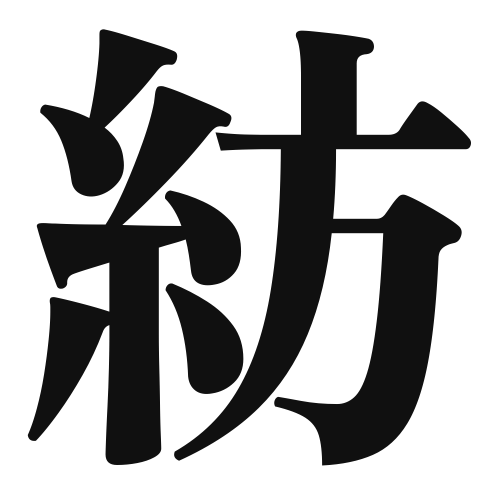1. Overview of Meaning
The kanji “紡” (pronounced “bō” in Japanese) means “to spin” or “to weave.” It is commonly associated with the process of turning fibers into thread or yarn, which is a fundamental aspect of textile production.
2. Formation and Radical
Formation of the Kanji: The kanji “紡” is a phonetic-ideographic character (形声文字). It combines the radical for “silk” (糸) on the left, which indicates its relation to textiles, and the phonetic component “亡” (bō) on the right, which contributes to its pronunciation.
Radical: The radical of “紡” is 糸 (ito), which means “thread” or “silk.” This radical is commonly found in kanji related to textiles and weaving.
3. Examples of Usage
Common Words and Phrases:
- 紡績 (ぼうせき, bōseki) – spinning (textiles)
- 紡ぐ (つむぐ, tsumugu) – to spin or weave
Example Sentences in Daily Conversation:
- 彼女は自分の服を紡いでいる。 (かのじょはじぶんのふくをつむいでいる。) – She is spinning her own clothes.
- この工場では糸を紡ぐ技術が使われている。 (このこうじょうではいとをつむぐぎじゅつがつかわれている。) – This factory uses technology to spin thread.
4. Synonyms and Antonyms
Similar Kanji:
- 織 (おり, ori) – to weave; while “紡” refers to spinning fibers into thread, “織” refers to the process of weaving those threads into fabric.
Antonyms:
- 解く (ほどく, hodoku) – to untie or unravel; this is the opposite of the process of spinning and weaving.
5. Cultural and Historical Background
Relation to Japanese Culture: The art of spinning and weaving has deep roots in Japanese culture, with traditional practices still being celebrated today. Textiles play a significant role in Japanese clothing, such as kimono.
Proverbs and Idioms: One common saying is “糸を紡ぐ” (いとをつむぐ, ito o tsumugu), which metaphorically means to create or build something gradually, similar to how threads are spun together to form a fabric.
